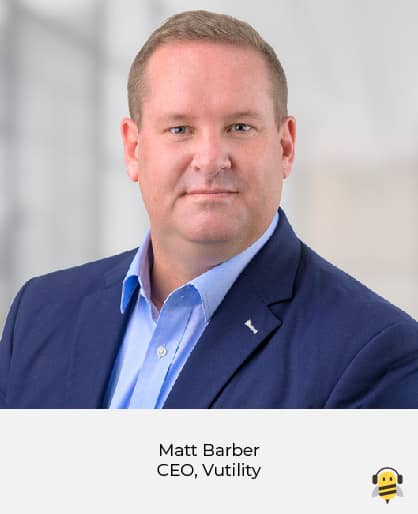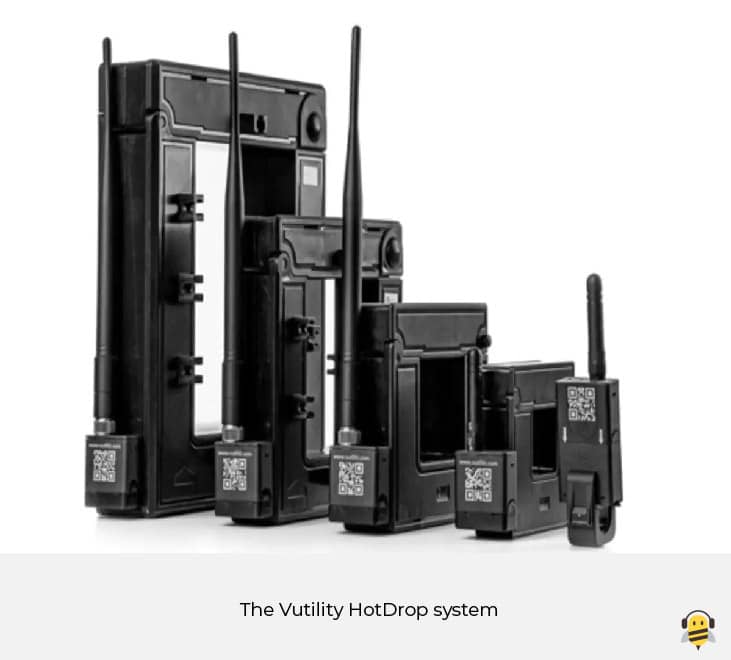

Vutility (Sandy, Utah) is a leading-edge technology company in the energy and environmental space, offering solutions for data gathering, sensor monitoring, submetering, cloud computing and analytics for an organization’s most critical assets. While measuring a system’s energy usage is nothing new, Vutility promises something a typical power company can’t: access to real-time, ultra-granular data not normally served up at scale. As Matt Barber, CEO of Vutility puts it, “It has always been shocking to me how little the world’s largest companies actually know about their most mission-critical assets. Without sounding sacrilegious, our technology is essentially giving sight to the blind.”
 Vutility’s sensor data depends on three core products: HotDrop, PulseDrop, and later this year, VoltDrop. HotDrop is a sub-metering solution providing minute-by-minute data instantly. PulseDrop reads any meter that provides a dry pulse output, an industry-standard metric for most electric, water and natural gas meters around the world. VoltDrop allows service providers to install a full meter with full power factor, how a normal meter performs but at a reduced cost and time to install. “Combining the HotDrop, PulseDrop and VoltDrop together with our world class cloud data management solution,” Barber explains, “Vutility delivers something very unique to the energy space.”
Vutility’s sensor data depends on three core products: HotDrop, PulseDrop, and later this year, VoltDrop. HotDrop is a sub-metering solution providing minute-by-minute data instantly. PulseDrop reads any meter that provides a dry pulse output, an industry-standard metric for most electric, water and natural gas meters around the world. VoltDrop allows service providers to install a full meter with full power factor, how a normal meter performs but at a reduced cost and time to install. “Combining the HotDrop, PulseDrop and VoltDrop together with our world class cloud data management solution,” Barber explains, “Vutility delivers something very unique to the energy space.”
This ultra-sophisticated sensor system is designed for an organization’s most complicated, technical, and expensive equipment—installable at any level and any circuit. “Any machine can have a usage meter, but that’s just a basic measurement so your utility company can send a bill,” Barber explains. “Our tech gathers the data that can then give in-depth information on an asset’s energy signature, including health, cost analysis, functionality, predictive failure and maintenance. It’s the ‘micro metering,’ or ‘meter behind the meter’ for organizations operating on high-functioning assets.”
According to Barber, Vutility sensors gather consumption and anomalous behavior data in real time, simultaneously working toward generating a baseline algorithm to predict failure. It’s a full energy suite to provide granular visibility that any kind of critical asset manager would want to understand.
The sensor suite’s usage applications are especially impressive considering the affordability and reliability of the technology. “With our unique competitive advantage, we’re producing an industry-leading solution that’s cheaper, better, and faster,” explains Barber. “Industries can get scaled actionable data at a fraction of the price and labor of traditional methods.”
 Key to the cost and manufacturing piece, Barber explains, is Vutility’s leadership. Michael Austin, CTO at Vutility, worked for fifteen years in Motorola’s manufacturing, the “original IoT device: the cell phone” as Barber puts it. According to Barber, Austin’s experience was fundamental to designing and building Vutility’s hardware at scale. Their CIO, James Archuleta, came from Oracle, bringing a history of analytics and data lab management to Vutility’s information technology and data delivery solutions; he’s been the key driver behind Vutility’s cloud solution.
Key to the cost and manufacturing piece, Barber explains, is Vutility’s leadership. Michael Austin, CTO at Vutility, worked for fifteen years in Motorola’s manufacturing, the “original IoT device: the cell phone” as Barber puts it. According to Barber, Austin’s experience was fundamental to designing and building Vutility’s hardware at scale. Their CIO, James Archuleta, came from Oracle, bringing a history of analytics and data lab management to Vutility’s information technology and data delivery solutions; he’s been the key driver behind Vutility’s cloud solution.
 “We have a phenomenal team,” says Barber. “What’s actually been paramount to our success is we’ve done things backwards. Normally an IoT company will start with building their backend data infrastructure, visualizations, and admin tools. What they don’t realize is that’s probably the easy part. Then they move on to making their hardware and make a prototype—only to realize they can’t produce at scale and get the cost or production right. Vutility went the other direction: We aced manufacturing scale, hardware, cost, and product quality before anything else.”
“We have a phenomenal team,” says Barber. “What’s actually been paramount to our success is we’ve done things backwards. Normally an IoT company will start with building their backend data infrastructure, visualizations, and admin tools. What they don’t realize is that’s probably the easy part. Then they move on to making their hardware and make a prototype—only to realize they can’t produce at scale and get the cost or production right. Vutility went the other direction: We aced manufacturing scale, hardware, cost, and product quality before anything else.”
Vutility sensors are useful for individual organizations looking to track energy usage and functionality, but the go-to-market strategy is more macro-focused: gathering and distributing better data for service providers through a multi-channel partner model. “A lot of companies are already engaged with energy savings companies and analytics providers,” says Barber. “We’re going to the actual service providers to get them better data, generate baselines and benchmarks, and understand basic functionality of critical machines.”
According to Barber, the typical process extracting data out of an organization is laborious and energy intensive. Vutility uses an IoT protocol called LoRaWAN (a media access control [MAC] layer protocol designed for large-scale public networks with a single operator) to backhaul data thousands of feet through a building—through metal and concrete, using small amounts of power but at a long range.
 Most of their customers, Barber explains, have a hierarchical structure of assets with energy signatures, scaling from the whole system to individual circuit level to aggregate a host of data. “With traditional metering solutions, Say someone is trying to monitor fifty air conditioners in one building; each meter will cost approximately $5k installed and you still don’t get any data backhauled and sent to the Cloud. Vutility can do it for a tenth of the cost and give you real-time data, source to screen. To be able to offer that to a building owner or sustainability manager struggling to understand their energy usage—it’s exhilarating.”
Most of their customers, Barber explains, have a hierarchical structure of assets with energy signatures, scaling from the whole system to individual circuit level to aggregate a host of data. “With traditional metering solutions, Say someone is trying to monitor fifty air conditioners in one building; each meter will cost approximately $5k installed and you still don’t get any data backhauled and sent to the Cloud. Vutility can do it for a tenth of the cost and give you real-time data, source to screen. To be able to offer that to a building owner or sustainability manager struggling to understand their energy usage—it’s exhilarating.”
Another of Vutility’s unique features is wireless operation, no batteries necessary. “You have your machinery or equipment, and you place the HotDrop on a wire with energy running through it and it harvests the magnetic field, like charging a cell phone inductively. The magnetic flux is small, so we had to have the tech super dialed in to be an energy-light processor.”
With an enterprise scope on top-to-bottom infrastructure management and sustainability applications, Vutility has its sights on a range of multi-location, inter-sensor integrations, expanding their IP applications to become a full energy-platform-as-service company.
“One thing I love about Vutility is we’re continually iterating and inventing all the time,” says Barber. “Our mission statement is ‘Change the way the world works through data that matters.’ The way I see it is if any critical asset in the world has energy running through it and someone cares about its health, cost to operate, or performance, they should have Vutility sensor on it.”

